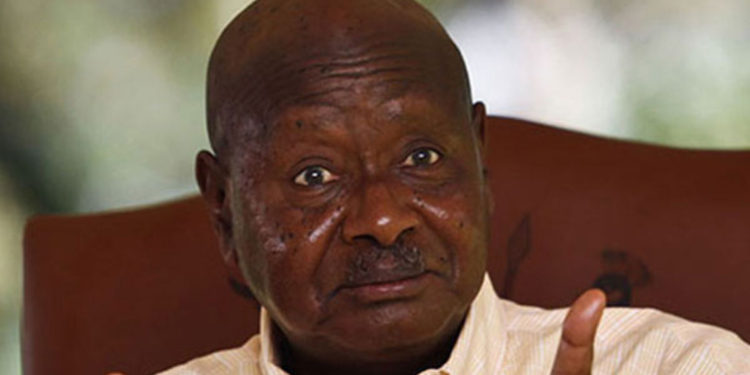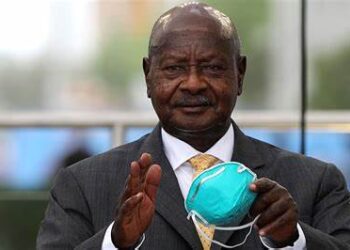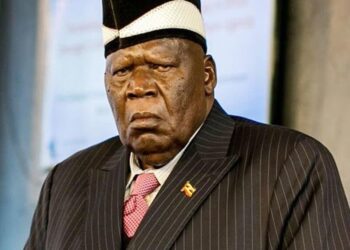In a jaw-dropping display of political theatre, President Museveni commandeered the entire Ugandan government to his presidential farm in Kisozi, Gomba District. The Vice President, Chief Justice, Speaker of Parliament and her deputy, along with the NRM Secretary General and Central Executive Committee members, were all obliged to attend. Even journalists, eagerly anticipating a major announcement, were drawn into this peculiar assembly.
However, instead of unveiling any significant political revelation, Museveni led his entourage on an ostentatious tour of four model farms in Sembabule and Gomba districts. This carefully staged event was a quintessential Museveni maneuver—an elaborate, self-serving display aimed at reinforcing his message of agricultural wealth creation.
The first stop was Yusuf Ssuuna’s 20-acre coffee farm in Lutunku Parish, Kyabi Subcounty, Sembabule. The convoy then moved to Anthony Ssonko’s farm in Kisozi Parish, Kifampa Subcounty, Gomba, before visiting two other model farms. Each farm was a symbol of the success that Museveni’s agricultural gospel purportedly promises—a message he seemed desperate to imprint on his audience.
Then nature added its own dramatic twist with a downpour, transforming the farms into muddy obstacle courses. Ministers, clad in sneakers and city attire, floundered through the mire—a spectacle that would have been comical if it weren’t so blatantly orchestrated. It was as if the weather itself had conspired with Museveni to ensure his message was indelibly etched into the minds of his top officials. The ministers’ struggles in the mud served as an apt metaphor for the relentless effort Museveni demands in spreading his agricultural vision.
These farm visits were not casual jaunts but strategically selected showcases meant to underline Museveni’s narrative of economic transformation. His goal was transparent: he wanted his ministers and government officials to see firsthand the supposed rewards of agricultural dedication and to propagate this narrative in their own regions.
Yusuf Ssuuna’s story was particularly spotlighted. Starting with a mere five acres in 1988, Ssuuna switched from maize to coffee, realizing the latter’s greater profitability. A pivotal workshop by the National Agricultural Advisory Services (NAADS) in 2011 reinforced his focus on coffee. Over the years, he expanded his coffee acreage to 20, now earning an impressive Shs30 million annually.
Another farmer extolled Museveni’s wealth creation initiatives in Kyayi subcounty, boasting of selling over 300,000 litres of milk daily. This transformation from poverty was attributed to Museveni’s introduction of goats, coffee, and dairy cows. His daily production of 800 litres of milk was a testament to the president’s influence. The farmer’s assertion that he and his peers were now wealthier than many educated individuals was a powerful endorsement of Museveni’s agricultural policies.
The grand finale was a guided tour of Museveni’s own farm at Kisozi. Personally chauffeuring himself in the official presidential vehicle, Museveni led the convoy through his expansive agricultural estate. The sight left many officials shaking their heads in astonishment—a vivid, unspoken message about the success and prosperity Museveni claims is achievable through dedication to agriculture.
However, the real takeaway wasn’t in the farms’ splendor or the farmers’ success stories. It was the stark, blatant demonstration of Museveni’s capacity to mobilize the entire government machinery to underscore his personal and political agenda. This was a masterclass in political choreography, blending showmanship with substance.
Critics could easily dismiss the event as a mere spectacle, a diversion from urgent national issues. The timing and grandeur of the tour could be seen as a blatant attempt to reinforce Museveni’s dominance and assert his continued relevance. It raises critical questions about the propriety of using state resources for what was essentially a political parade.
Was this tour a genuine strategy for promoting agricultural development, or was it an indulgent display of Museveni’s power? The sight of high-ranking officials floundering through muddy fields may have been entertaining, but was it necessary? Could the same message have been conveyed through more practical, less ostentatious means?
As the spectacle concludes, many questions remain unanswered. Why the urgency and grand scale of this tour? Was there a deeper political motive? What tangible benefits will this spectacle bring to the average Ugandan farmer? The image of mud-splattered ministers against the backdrop of lush, productive farms starkly highlights the chasm between policy and practice, between the halls of power and the realities of rural life.
In the end, Museveni’s farm tour was more than a message about agriculture. It was a bold statement about leadership, control, and the art of political theatre. Whether this will translate into real benefits for the populace remains uncertain. For now, it stands as a testament to Museveni’s theatrical flair and his unrelenting drive to keep his vision at the forefront of Uganda’s national agenda.







Discussion about this post